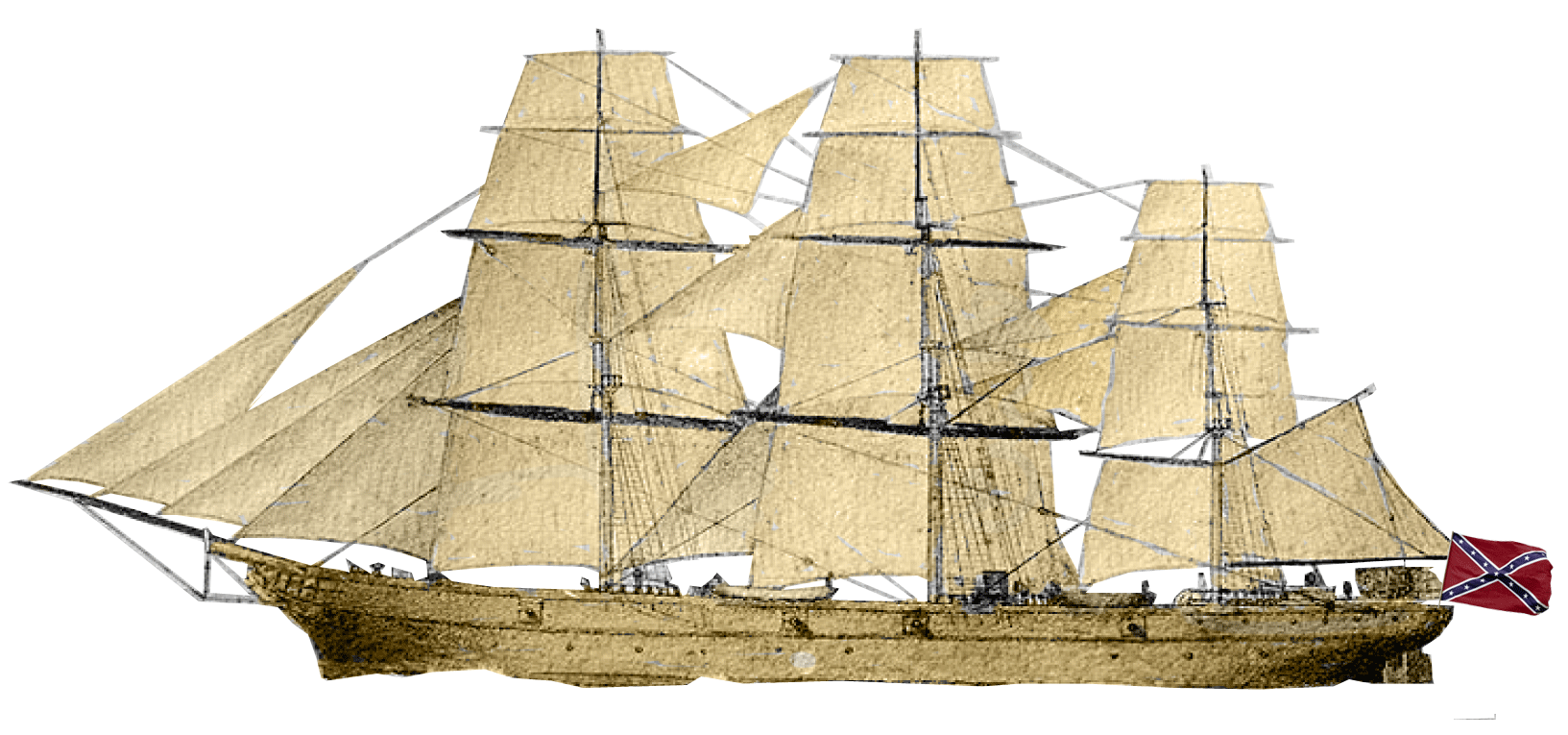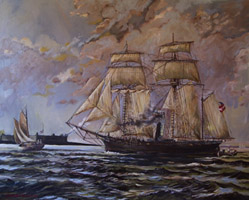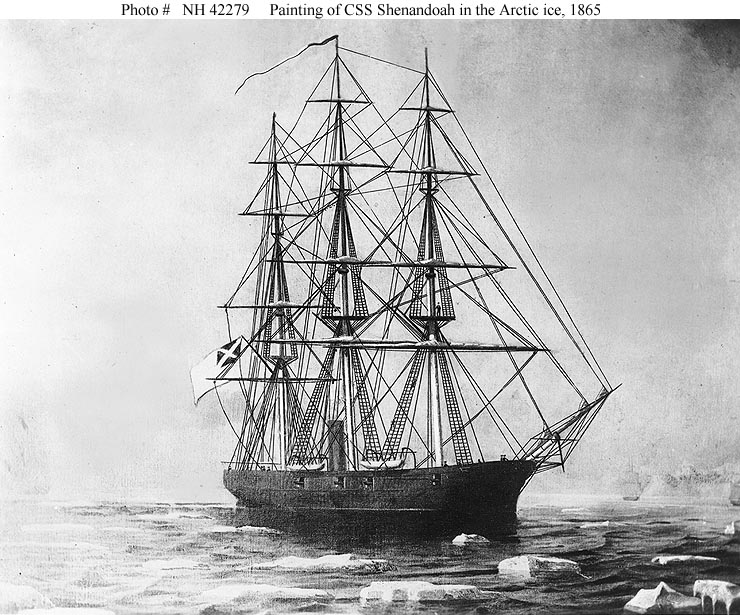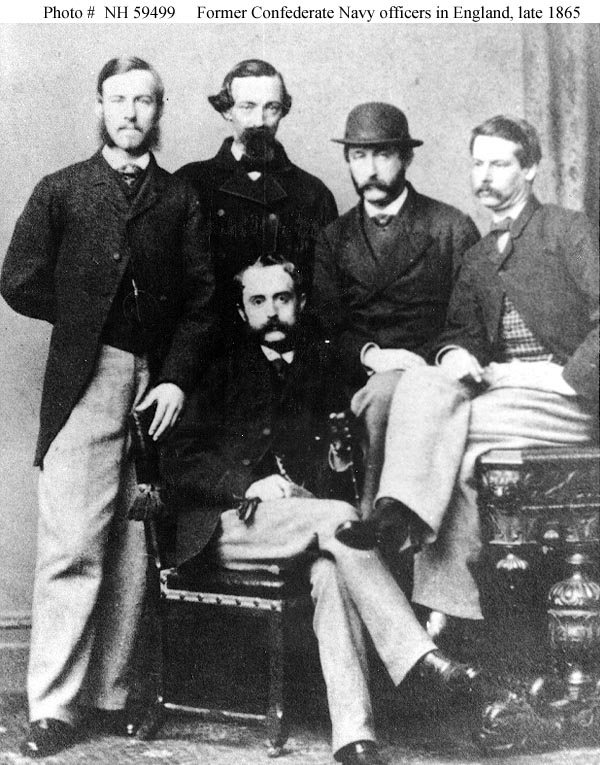 CSS Shenandoah
CSS Shenandoah 

Nation: Confederate States of America
Type: Commercial Raider
Shipyard: A Stephen & Sons - River Clyde
Launched: August 17th 1863 (As Sea King)
Commissioned: Octobber 18 1864
Fate: Surrendered - River Mersey, England November 6 1865
Displacement: 1160 tons
Length: 230 ft Beam: 32 ft Draft: 20 ft 6 inches
Propulsion: Sails with Steam auxiliary
Speed: 9 knots (steam)
Complement: 109
Guns: 4 x 8 inch smooth bore; 2 x 32 pounders; 2 x 12 pounder guns
What on earth is a Confederate warship doing here in my Wirral pages you ask? Built in 1863, as the Sea King, american owners, who said they were using her to ferry troops in the far east. But when she set sail for the Far East, it was not to be her destination. After a 1 year or so life at sea, attacking Unionist shipping, she was still fighting in the seas off Alaska when the conflict came to a close, but word got out to her too slow to prevent her attacking more Unionist ships afterwards. In fact it was a British ship that warned her. Fearing a bloody retribution, the Captain and crew decided to head for England, crossing the Pacific Ocean from Alaskan waters to arrive off the River Mersey on November 6th 1865. Considerable excitement was caused when the steamer Douglas reported the warship sitting in the bay, awaiting high tide. The Captain of the Shenandoah asked if there was a British Naval warship in port, which there was, and he was allowed into the River Mersey to come along side the warship to officially surrender to Great Britain. Despite American appeals, the British Government refused to allow the crew to be turned over to them.
Laid down on the River Clyde in Scotland, CSS Shenandoah was designed as the British troop transport Sea King. Launched from the yard of A. Stephen & Sons on August 17, 1863, the ship possessed iron framing and teak planking. For propulsion, Sea King relied on sails and an auxiliary steam engine. Shortly after it was completed, Confederate agent James Bulloch noticed the new ship at anchor and began making plans to acquire it for use as a commerce raider. Bulloch's actions did not go unnoticed as US agent Thomas Dudley alerted Ambassador Charles Francis Adams of Bulloch's intentions.
As US Secretary of State William Seward had repeatedly warned the British Government about allowing the Confederates to purchase ships and weapons, Bulloch was forced to act covertly to avoid further detection by American and British authorities. Utilizing a variety of ruses and covert operations, he succeeded in purchasing Sea King as well as a tender, Laurel. On October 8, 1864, Sea King departed London for an announced trading voyage to India. Arriving at Funchal, Madeira, Sea King rendezvoused with Laurel which had sailed with guns and military stores. Here the Sea King was equipped for war and renamed the Shenandoah.
Report from the Liverpool Mercury for Tuesday 7th Nov. 1865.THE CONFEDERATE CRUISER SHENANDOAH IN THE MERSEY.

Shenandoah
passes Fort Perch as she enters the Mersey
Considerable excitement was caused on "Change" yesterday morning by circulation of the report that the Confedcrate cruiser Shenandoah, of whose exploits amongst the American whalers in the North Pacific so much has been heard, was passed about 8 o'clock by the steamer Douglas at anchor at the bar, of Victoria Channel, apparently waiting or high water. By many the report was discredited, it being thought that those on board the Douglas were in error, and had mistaken some other craft for the celebrated ex-Confederate cruiser. At half past ten, however, all doubts on the point were set at rest, with the Shenandoah steaming up the Victoria Channel with the Palmetto flag flying from her masthead.
The proceedings of this cruiser have caused much anxiety amongst commercial men. Afier Richmond was taken, and when the Government of the, Confederate States was considered a thing of the past, Captain Waddell startled those who trusted their merchandise on board American ships, by misbeleiving, or affecting to misbeleive, that the Confederate States had been broken up; and continued his depredations upon peaceful merchantmen. This conduct caused much irritation among the American merchants and shipowners, and one or two of the fleetest ships in the United States navy were sent in pursuit of the Shenandoah.
She, however, succeeded in eluding the vigilance of her pursuers, and the last that was heard of her whereabouts was that she was off St. Lawrence in the Arctic Sea. And that in that locality she had destroyed 10 whalers, most of which had cargoes of oil, and were bound for the United States. She was then steering in a southerly direction, and there can be little doubt that she was tracing her course towards England.
The career of this vessel has been somewhat eventful. She formerly belonged to the British Government, was known as the Sea King, and sailed from London; a short time before the close of the American war. She went over to Brest, having on board some officials connected with the Government dockyard. It was then stated that she was intended for a Confederate cruiser, and much indignation was expressed, that she should have been allowed to leave a British port, and that Government officials should have been allowed to have anything to do with the transaction.
On her arrival at Brest, the French Government having been acquainted of the purpose for which she would be used, those in charge of her found it desirable to leave the port as early as possible, which they did without being able to complete either her armament or her fittings.
Notwithstanding the reverses that the Confederacy had sustained, there were men who professed to be hopeful of the ultimate success of the cause, Grant and Sherman might obtain victories in the field, but if the American mercantile marine could be harassed, if the commerce of the Northern cities could be hampered and the interests of capitalists thereby affected, it was argued that a blow would be struck in favour of the South, which would counterbalance the success of the Northern armies.
Looking at the matter from this point of view, it was determined by those who "hoped against hope", to arm the Shenandoah, fit her out as a first class cruiser, and let her loose upon American merchant shipping. She was accordingly met at Madeira, by a steamer, which it was stated had sailed from Liverpool, and her armament, after some difficulty, was put aboard. A short time after, she was heard of at Melbourne, where she put in for supplies. At that port she coaled, and took in the supplies necessary for the continuance of her cruise. The action of the Colonial Government was much blamed in this matter, and it was urged by friends of the North, that it was a breach of international law, to allow such a vessel as the Shenandoah, to go into a port belonging to a neutral power and refit, so as to enable her to continue her depredations upon peaceful merchantrnen. On the other hand however, it was contended that, while she lay in Melbourne she was closely watched, that she was not allowed to take on board any munitions of war, that steps were taken to prevent the recruiting of her crew, and that she was only permitted to take on board such stores, and make such repairs, that would enable her to continue her voyage in safety, to what might be a neutral port.
The vessel sailed from Melbourne, and when next heard of was in the Ochatak Sea and in Bering Straits, where she did much damage to the American whaling vessels. It is said that she destroyed 37 American vessels in all, and it is well known that in consequence of her depredations, insurance on certain freights were with difficulty effected, and that sperm oil advanced considerably in price - in some cases from £70 to £120 per ton.
Captain Waddell, the commander of the Shenandoah, states that the last vessel he spoke to was the Barracouta, of Liverpool, bound for San Francisco. He met this vessel at sea on 3rd of August, and leamed from the captain that the cause of the South was irretrievably lost. Captain Waddell, on hearing this news, expressed his intention to proceed to England, and arrived off this port yesterday morning. He then took a pilot on board, and, fmding the intelligence he had received from the captain of the Barracouta as to the subjugation of the South undoubted, he desired the pilot to take his ship alongside one of her Majesty's vessels of war, if there were any in port. The Shenandoah was taken up the river at high water, and, according to the instruction given to the pilot, she was moored alongside the Donegal. A crew from that vessel was placed on board her, and the customs authorities having been communicated with, some officers belonging to that department were also placed in charge. Soon after the surrender of the vessel, Captain Waddell and several of his officers and crew went on shore.
Since the defeat of the South, the flag of the Confederation has seldom, if ever, been seen on the Mersey. As might be expected, therefore, the appearance of a steamer in the river flaunting the Palmetto excited considerable attention, and, as we have stated, some apprehension was felt as to the intention and destination of the redoubtable stranger.
The Shenandoah is a smart, handsome looking craft, with black painted hull and unmistakably rakish rig, and appears to be altogether a quick and serviceable vessel. She has a crew of 130 men, and a ballast of coals.
At the present juncture, when so many knotty points of international law are at issue between this Government and the United States, and when the maintenance of amicable relations between the two countries is so much to be desired, and is so essential to the welfare of both, the absence of the Shenandoah from this port was more to be desired than her presence. There can be little doubt that after the necessary formalities are gone through, the vessel will be handed over to the United States authorities. However, some question may arise as to the detention of her crew, a subject that may lead to misunderstandings that had better been avoided.
It is understood that a representative of the American Government at this port has been, since the arrival of the vessel, in communication with the customs authorities. It is also stated, that certain commercial houses, who were said to be deeply interested in the success of the Confederacy, were engaged yesterday in making enquiries in regard to the Shenandoah.
Liverpool Mercury Thursday 9th Nov. 1865.
THE SHENANDOAH.
PAROLE OF THE CREW.
The government have at length taken a decided step in regard to the crew of this vessel. For the last two days the authorities in Liverpool have been in communication with the Secretary of State in reference to the detention of the ship and her crew. The Government seem to have been decided as to the necessity of retaining the vessel, pending an inquiry as to the action which her commander and crew have taken during the last few months, but there seems to have been some doubt as to the proper course to adopt with reference to the men on board. On inquiry at the Custom House yesterday morning, we were informed that the authorities had not received further instructions as to the vessel or her crew.
However, about 6 o`clock last night a telegram was received from Government by Captain Paynter, of her Majesty's ship Donegal, to whom the Shenandoah was surrendered, that the whole of the officers and crew, who were not British subjects were to be immediately paroled. (A commission of lawyers had convened and decided that the crew had not committed piracy as the US claimed and had not gone beyond their remit of war, there was no case to answer - mk) Captain Paynter immediately proceeded to the Rock Ferry slip, and applied for a steamboat. The Rock Ferry steamer Bee was placed at his disposal by Mr. Thwaites, in which he immediately proceeded alongside the Shenandoah. Captain Paynter went on board and communicated to the officers the object of his visit. The crew were mustered on the quarterdeck by the officers of the ship, the roll book was brought out, and the names of the men called out as they occurred. As each man answered to his name he was asked what countryman he was. In not one instance did any of them acknowledge to be British citizens. Many nations were represented among them, but the majority claimed to be natives of the Southern States of America or "Southern citizens". Several of those however, who purported to be Americans, had an unmistakably Scotch accent, and seemed more likely to have hailed from the banks of the Clyde than the Mississippi. Captain Paynter informed the men that by order of the Government they were all paroled, and might proceed at once to shore. This intelligence was received by the men with every demonstration of joy, and they seemed to be delighted at the prospect of leaving the craft in which they had hoped to be able to assist the Southern Confederacy. They commenced to pack up their bedding and other articles as fast as possible, and conveyed on board the Bee, which was to take them to the landing stage. Before leaving the vessel, however, they gave three lusty cheers, for Captain Waddell, their late commander. Captain Waddell, in feeling terms, acknowledged the compliment, and said that he hoped the men would always behave themselves, as brave sailors ought to do. The men then went aboard the Bee, and were conveyed to the landing stage. This separated the Shenandoah and her crew, and the vessel now rides at anchor in the Sloyne in charge of some men from the Donegal, under the command of Lieutenant Cheek.
The arrival of the late crew of the Shenandoah caused no small stir. People were surprised to see the landing of a number of swarthy-complexioned, weather-beaten men, dressed in grey uniform, and wearing eccentric looking hats and caps. When it became known that they were the crew of the notorious cruiser, a large crowd of persons assembled, who stood watching the sailors as they were taking their baggage on shore. Some people were desirous of knowing their cause of leaving the vessel, and their intended movements, but the sailors were discreetly silent, and the questioners were not able to pump much out of them. They were for the most part, able bodied, determined looking fellows, and would, no doubt, have proved themselves equal to the work they had in view.
It has been stated that Captain Waddell, and several officers and crew of the Shenandoah went on shore before the parole was received. This, we are assured, is not the fact, and that none of those on board (except for three who escaped) left the vessel until they were paroled. It is stated that the Shenandoah has about 35 chronometers on board, a large quantity of cabin furniture and some oil. All the guns of the Shenandoah are stowed away in her hold. The vessel continues to be an object of curiosity to crowds of people on the banks of the river, and the passengers on board the ferry steamers.

Shenandoah in the Arctic ice
From the Liverpool Mercury 10th Nov. 1865
The Shenandoah
The following letter is said to have been addressed to Earl Russell by Capt. Waddell, who commanded the Shenandoah.
"To the Right Hon. Earl Russell, H.B.M. Minister for Foreign Affairs."
Steamer Shenandoah, Nov. 5
"My Lord,
I have the honour to announce to your lordship my arrival in the waters of the Mersey with this vessel, lately a ship of war in my command, belonging to the Confederate States of America. The singular position in which I find myself placed, and the absence of all precedents on the subject, will, I trust, induce your lordship to pardon a hasty reference to a few facts connected with a cruise lately made by this ship. I commissioned the ship in October 1864, under orders from the naval department of the Confederate States, and in pursuance of the same commenced actively cruising against the enemy's commerce. My orders directed me to visit certain seas in preference to others. In obedience thereto I found myself in May, June and July of this year in the Oshtok sea and the Arctic Ocean. Both places, if not quite isolated, are still so far removed from the ordinary channels of commerce that months would elapse before any news could reach there as to the progress or termination of the American war. In consequence of this awkward circumstance I was engaged in the Arctic Ocean in acts of war so late as the 28th June, in ignorance of the series of reverses by our arms in the field, and the obliteration of the Government under whose authority I had been acting. This intelligence I received for the first time on communicating at sea, on the 2nd August, with the British barque Barracouta of Liverpool, 14 days from San Francisco. Your lordship can imagine my surprise at the receipt of such intelligence, and I would have given it little consideration if an Englishman did not confirm the war news, though from an enemy port.
I desisted immediately from further acts of war, and determined to suspend further action until I had communicated with a European port, when I would learn if that intelligence was true. It would not have been intelligent in me to convey this vessel to an American port, simply because the master of the Barracouta had said the war was ended. I was in an embarrassing position. I diligently examined all the law writers at my command, searching for a precedent for my guidance in the future control, management, and final disposal of the vessel. I could find none: History is, I believe, without a parallel. Finding the authority questionable under which I consider this vessel a ship of war, I immediately discontinued cruising, and shaped my course for the Atlantic Ocean. As to the ship's disposal, I do not consider that I have any right to destroy her or any further right to command her. On the contrary, I think that as all the property of the Confederate Government has reverted, by the fortune of war, to the Government of the United States of North America, therefore this vessel, inasmuch as it was the property of the Confederate States, should accompany other property already reverted. I have, therefore, sought this port as a suitable one "to learn the news," and, if I am without a Government, to surrender the ship, with her battery, small arms, stores, tackle, and apparel complete to Her Majesty's Government, for such disposition as in its wisdom should be deemed proper. I have the honour to be,
very respectfully, your lordship's obedient servant,
Jas. I. Waddell, Commander.

The above image was taken in Leamington Spa and
shows several of the former officers of the Shenandoah
Those present include former Assistant Surgeon Edwin G. Booth (seated),
and (standing, left to right):
former Acting Master Irvine S. Bulloch (of CSS
Shenandoah);
former Passed Assistant Surgeon Bennett W. Green;
former First Lieutenant William H. Murdaugh; and
former Passed Assistant
Surgeon Charles E. Lining (of CSS Shenandoah).
The battle ensign of CSS Shenandoah is unique amongst all of the flags of the Confederate States of America as it was the only Confederate flag to circumnavigate the Earth during the Confederacy, and it was the last Confederate flag to be lowered by a combatant unit in the Civil War (Liverpool, UK, on November 6, 1865)
In 1866 the US, having taken possession of Shenandoah, sold her to the first Sultan of Zanzibar, who renamed her after himself (El Majidi). On April 15, 1872 a hurricane hit Zanzibar. Shenandoah (El Majidi) was one of 6 ships owned by Seyed Burgash which were blown on shore and seriously damaged.
Shenandoah's battle ensign has been in the Museum of the Confederacy's collection since 1907 and is currently on display. Lieutenant Dabney Scales CSN, gave the flag to a cousin, Eliza Hull Maury, for safekeeping. Eliza Hull Maury was a daughter of and Richard Launcelot Maury was the eldest son of Commodore Matthew Fontaine Maury. Colonel Richard Launcelot Maury CSA, Eliza's brother, brought the flag from England in 1873, and donated it to the Museum in 1907. The flag itself measures 88" x 136."
Confederate Bazaar - In October 1864 Liverpool staged a bazaar at St George's Hall called the 'Southern Prisoners' Relief Fund'. It lasted for 5 days and raised over £20,000. The stalls included a raffle for a donkey! A modern day connection to this is that the present secretary of "The Friends of St. George's Hall" is a direct relation of Lady Mildred Beresford Hope, one of the patronesses of the Grand Southern Bazaar.
The last offical Confederate Flag was lowered in Liverpool on 6 November 1865 when CSS Shenandoah, captained by Lieutenant Waddell, arrived in the Mersey. He lowered the flag and his ship was ultimately turned over to American authorities. President Lincoln was assassinated by John Wilkes Booth in 1865 just days after the surrender of the Confederates. Booth's father, Junius Booth, a Shakespearean actor, came from Liverpool.

